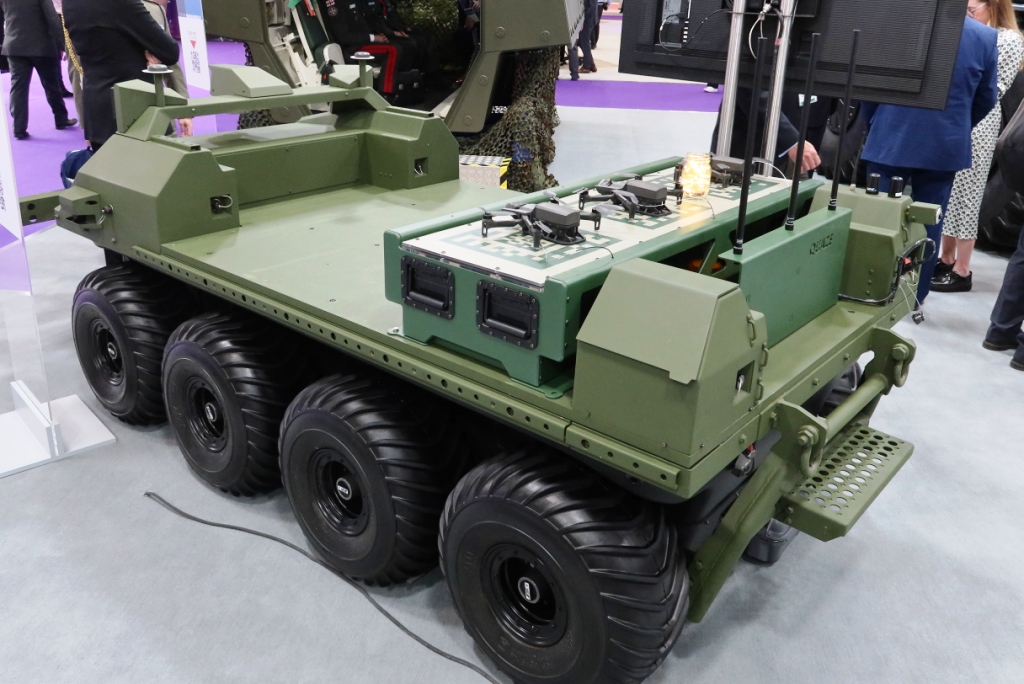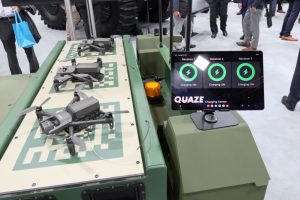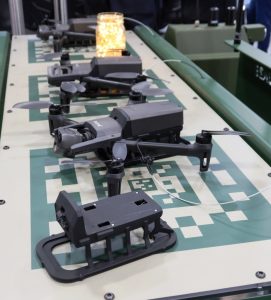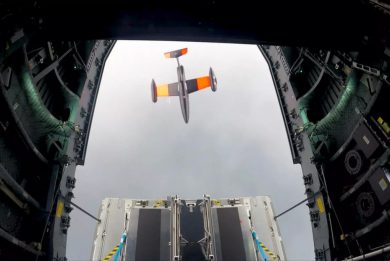
DSEI 2023 – Rheinmetall Mission Master SP with Quaze DSTOW™ ensure unmanned permanent surveillance
At DSEI 2023 Rheinmetall exhibited its Mission Master SP unmanned ground vehicle fitted with Quaze Technologies’ Drone Swarm Tactical Over Watch (DSTOW), the couple being able to provide unmanned permanent surveillance to tactical units
Deploying ahead of a military tactical formation a UGV capable to carry a vertical take-off and landing UAV can considerably increase the unit commander’s reconnaissance capabilities as well as the unit situational awareness. The problem is that electrically powered Class 1 UAVs usually have limited endurance, therefore providing surveillance on extended periods of time becomes difficult.

Adding a battery reloading system to the UGV is the solution, and this is what Quaze, a Canadian SME based in Saint-Jean-sur-Richelieu developed. Such a system had obvious applications in many fields, one being the military, and to develop it according to military needs Quaze did the most obvious thing: team up with major defence company such as Rheinmetall Canada, which not only is developing most UGVs within the German industrial group, but is also based in the same town, which makes cooperation much easier.
The DSTOW comes in the form of a landing platform, which can be produced in any size but in the case of its integration on Rheinmetall’s Mission Master SP 8×8 wheeled heavy multirole UGV it is located at the rear of the vehicle and covers its full width. This allows having three landing spots for UAVs, the landing charging zone being around 1.2 x 0.3 metres, the system allowing simultaneous recharge of all three UAVs.
Quaze does not employ a magnetic field technology for recharging but one a based on magnetic resonance. This technology offers a seamless and efficient solution to power multiple devices across a wide surface area, and allows maintaining a low electromagnetic signature, a key issue in the military world. Quaze DSTOW has the considerable advantage to ensure recharging even if the UAV and the platform are not in direct contact, charging distance being up to 50 mm, and doesn’t require precise alignment. This means that battery reloading will be performed in any condition such as snow, rain, sand, etc. It also opens up non-UGV related alternatives, a fixed stealth unloading point can for example be hidden under the sand providing a “gas station” for UAVs operating in the area. The system, which weighs 42 kg in the size adopted on the Mission Master, can be powered by different sources, typically 24 V/48 VDC or 120V/240 VAC.

The platform is capable to provide up to 300 W reloading power; this will be the final output for the production version, however Quaze representatives told EDR On-Line that in laboratory they managed to reach up to 500 W, which might open doors to future upgrades allowing recharging bigger UAVs.
To cope with the “eye-in-the-sky” concept, a relieve in place scheme can be adopted thanks to the DSTOW, a drone taking off and replacing the one in flight before the latter leaves the observation position to come back and “refuel”. Automated drone landing and take-off uses Quaze valet parking software with MavLink integration, the company offering customizable 60 W drone receivers. As option a GPS location/connection with MPU5 smart radio is offered.
According to Quaze, a first version of the system was put to trial with military units, and based on the feedback obtained the current version has been considerably improved. The company considers the system at TRL 6, and EDR On-Line understood the current version should soon start a further session of trials in the hands of the military.
Photos by P. Valpolini


